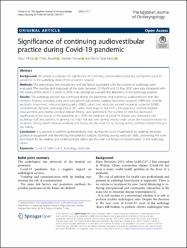| dc.contributor.author | Yılmaz, Oğuz | |
| dc.contributor.author | Bayazıt, Dilara | |
| dc.contributor.author | Yaman, Handan | |
| dc.contributor.author | Mutlu, Berna Özge | |
| dc.date.accessioned | 2021-02-19T08:12:36Z | |
| dc.date.available | 2021-02-19T08:12:36Z | |
| dc.date.issued | 2021 | en_US |
| dc.identifier.citation | Yılmaz, O., Bayazıt, D., Yaman, H. ve Mutlu, B. Ö. (2021). Significance of continuing audiovestibular practice during Covid-19 pandemic. Egyptian Journal of Otolaryngology, 37(1). https://dx.doi.org/10.1186/s43163-021-00073-1 | en_US |
| dc.identifier.issn | 1012-5574 | |
| dc.identifier.issn | 2090-8539 | |
| dc.identifier.uri | https://dx.doi.org/10.1186/s43163-021-00073-1 | |
| dc.identifier.uri | https://hdl.handle.net/20.500.12511/6566 | |
| dc.description.abstract | Background: We aimed to evaluate the significance of continuing audiovestibular practice during the Covid-19 pandemic in the audiology clinic of the university hospital.Methods: The precautions, test procedures, and risk factors associated with the practice of audiology were evaluated. The number and diagnoses of the cases between 23 March and 23 May 2020 were also compared with the results of the same 2 months in 2019 in an attempt to evaluate the alterations in the audiology practice.Results: The audiology practice has continued during the pandemic, and numerous audiovestibular tests like newborn hearing screening, pure tone and speech audiometry, auditory brainstem response (ABR) test, bedside vestibular assessment, videomystagmography (VNG), caloric test, vestibular evoked myogenic potential (VEMP), computerized dynamic posturography (CDP), video head impulse test (vHIT), intraoperative cochlear implant measurement, and postop cochlear implant fittings were performed. The number of tests has decreased significantly in the course of the pandemic (p < 0.01). No evidence of Covid-19 disease was detected in the audiology staff and patients. In general, no major risk was seen during testing under protective measures except for vestibular testing which induced vomiting and taking out the mask for lip reading during cochlear implant fitting in the elderly.Conclusion: It is possible to perform audiovestibular tests during the Covid-19 pandemic by wearing necessary protective equipment and disinfecting the potential surfaces. Vomiting during vestibular tests, uncovering the nose and mouth for lip reading, and small-sized test cabins are the main risk factors of contamination in the audiology clinics. | en_US |
| dc.language.iso | eng | en_US |
| dc.publisher | Springer | en_US |
| dc.rights | info:eu-repo/semantics/openAccess | en_US |
| dc.rights | Attribution 4.0 International | * |
| dc.rights.uri | https://creativecommons.org/licenses/by/4.0/ | * |
| dc.subject | Covid-19 | en_US |
| dc.subject | SARS-CoV-2 | en_US |
| dc.subject | Audiology | en_US |
| dc.subject | Vestibular | en_US |
| dc.title | Significance of continuing audiovestibular practice during Covid-19 pandemic | en_US |
| dc.type | article | en_US |
| dc.relation.ispartof | Egyptian Journal of Otolaryngology | en_US |
| dc.department | İstanbul Medipol Üniversitesi, Sağlık Bilimleri Fakültesi, Odyoloji Bölümü | en_US |
| dc.authorid | 0000-0003-1884-0246 | en_US |
| dc.authorid | 0000-0003-3075-8536 | en_US |
| dc.authorid | 0000-0003-2013-7285 | en_US |
| dc.identifier.volume | 37 | en_US |
| dc.identifier.issue | 1 | en_US |
| dc.relation.publicationcategory | Makale - Uluslararası Hakemli Dergi - Kurum Öğretim Elemanı | en_US |
| dc.identifier.doi | 10.1186/s43163-021-00073-1 | en_US |



















